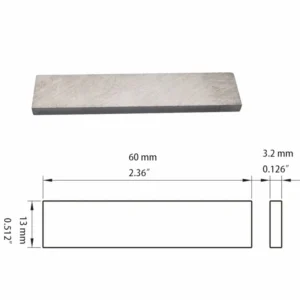Uncategorized
The magnetization direction determines the tone
Width magnetization direction determines the tone as follow:
Width magnetization direction:
- Wider magnets: Generally produce a stronger magnetic field, leading to a higher output and a fatter, thicker tone. Imagine a wider bar magnet casting a broader field across the strings.
Narrower magnets: Generate a weaker magnetic field, resulting in a lower output and a brighter, clearer tone. Think of a narrower magnet focusing its field on a smaller area of the strings.
Length magnetization direction:
- Longer magnets: Create a more even magnetic field across a wider range of string positions, leading to a consistent tone and better string balance. Picture a longer magnet stretching further under the strings.
Shorter magnets: Have a stronger magnetic field at the center and a weaker field towards the edges, resulting in a brighter tone for the center strings and a warmer tone for the outer strings. Imagine a shorter magnet concentrated around the middle of the strings.
Thickness magnetization direction:
- Thicker magnets: Generate a stronger magnetic field, offering a higher output and a fatter, punchier tone. Think of a thicker magnet as a more powerful engine driving the magnetic field.
- Thinner magnets: Produce a weaker magnetic field, resulting in a lower output and a brighter, more articulate tone. Imagine a thinner magnet as a more delicate instrument shaping the magnetic field.
Magnetization Direction of Alnico bar magnet:
As mentioned in the previous response, the direction of the magnet’s poles (perpendicular or parallel to the strings) significantly impacts the tone:
- Vertical Magnetization: Produces a brighter, clearer, and more articulate tone with emphasis on high frequencies.
- Parallel Magnetization: Offers a warmer, thicker, and smoother tone with focus on mid and low frequencies.
Axial magnetization direction determines the tone as follow:
- Axial (poles on ends): Similar to bar magnets, perpendicular for brightness, parallel for warmth.
Radial magnetization direction determines the tone as follow:
- Radial (poles on sides): More complex interaction, often emphasizing midrange and offering smoother response.
Combined effects: Wider rods with parallel magnetization can deliver a thick, punchy humbucker-like tone. Narrow rods with perpendicular magnetization might give a clear, focused single-coil character. However, radial magnetization introduces unique nuances that can’t be fully predicted from width and direction alone.
Remember: These are general tendencies, and the specific sound depends on the interplay of all these factors, alongside the pickup design, magnet type, and guitar wood. Experimenting with different combinations is key to finding your ideal voice!
Here’s a table summarizing the effects of each factor for quick reference:
I hope this expanded explanation with visuals helps you better understand the intricate interplay of the alnico bar magnet’s dimensions and magnetization direction in shaping your guitar’s sonic character!




-300x300.webp)


